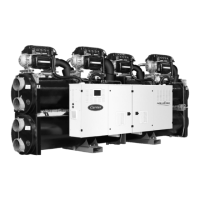4 - HARDWARE DESCRIPTION
4.1 - Control boards
Touch Pilot is the main controller that constantly monitors the unit
and manages the information received from various pressure and
temperature probes.
The control system includes the following modules:
- Touch Pilot (controller + 7-inch user interface).
- SIOB boards that manage the major inputs and outputs of
the controller (two SIOB boards for single-circuit units and
three SIOB boards for dual-circuit units).
- AUX1 board used for controlling options such as refrigerant
leak detection, master/slave assembly control or condenser
three-way valve.
- Dry Cooler Condenser AUX1 board which is installed in the
dry cooler (see section 8.15).
- Dry Cooler Free Cooling AUX1 board which is installed in the
dry cooler (see section 8.16).
All boards communicate via an internal bus.
4.2 - Power supply to boards
All boards are supplied from a common 24 VAC supply referred
to earth. In the event of a power supply interrupt, the unit restarts
automatically without the need for an external command. However,
any faults active when the supply is interrupted are saved and
may in certain cases prevent the unit from restarting.
CAUTION: Maintain correct polarity when connecting
the power supply to the boards, otherwise the boards may
be damaged.
4.3 - Light emitting diodes on boards
All boards continuously check and indicate the proper operation
of their electronic circuits. A light emitting diode (LED) lights on
each board when it is operating properly.
The red LED ashing for a two-second period indicates correct
operation. A different rate indicates a board or a software failure.
The green LED ashes continuously on all boards to show that
the board is communicating correctly over its internal bus. If the
green LED is not ashing, this indicates the internal bus wiring
problem or a conguration issue.
4.4 - Pressure transducers
The control implements two types of pressure transducers (high
pressure and low pressure) which are used to measure the suction
and discharge pressure in the circuit.
■ Discharge pressure transducers (high pressure type):
These transducers measure the discharge pressure in the circuit.
They are used to control condensing pressure or high pressure
load shedding. Discharge pressure sensors are mounted on the
discharge line piping of the circuit.
■ Suction pressure transducers (low pressure type): These
transducers measure the suction pressure in the circuit. They
are used to control EXV, evaporating pressure (in heating mode)
and monitor suction pressure safeties related to the compressor
operating envelope. Suction pressure sensors are located on
the suction piping of the circuit.
4.5 - Temperature sensors
Temperature sensors constantly measure the temperature of
various components of the unit, ensuring the correct operation
of the system.
■ Cooler entering/leaving water temperature sensors:
The cooler entering and leaving water temperature sensors are
used for capacity control and safety purposes. The water
temperature sensors are installed in the entering and leaving side.
■ Condenser entering/leaving water temperature sensors:
The condenser entering and leaving water temperature sensors
are used for heating capacity control and safety purposes.
■ Suction temperature sensors: Suction temperature sensors
are used to control temperature at the compressor inlet line in
order to ensure correct capacity control management (one sensor
per circuit).
■ Space temperature sensor: This sensor is used to measure
the space temperature.
■ DCFC option, Leaving Water Temperature sensor: This sensor
measures the dry cooler leaving water temperature. The sensor
measurement is used to control the operation of the dry cooler.
■ DCFC option, Water Loop Temperature sensor: This sensor
is used to measure the water loop temperature and it is mounted
before the water valve installed on the dry cooler. The sensor
measurement is used to verify if current conditions are suitable
for the free cooling process.
■ Air Condensing Control, Dry Cooler Leaving Water
Temperature sensor: This sensor is used to measure the
condenser water loop temperature at the exit of the Dry Cooler.
The sensor measurement is used to regulate the air exchange.
■ Air Condensing Control, Outdoor Air Temperature sensor:
This sensor is used to measure the air temperature around the
Dry Cooler. The sensor measurement is used to regulate the air
exchange.
■ Suction gas temperature sensors: Suction temperature
sensors (embedded / one per compressor) are used to control
temperature at the compressor inlet line in order to ensure
correct capacity control management. This sensor is located
at the suction side of each compressor.
■ Discharge gas temperature sensors: Discharge temperature
sensors (embedded / one per compressor) are used to control
the discharge gas temperature, and permit control of the
discharge superheat. This sensor is located at the discharge
side of each compressor.
■ Master/Slave water sensor (optional): This sensor measures
the common water temperature in the master/slave system
capacity control. It is installed only in the case of master/slave
units.
7

